A-Z
Disclaimer: do not eat any plant unless you can be certain it has been correctly identified. Do not remove plants from another person's property, or eat plants from polluted areas such as beside roads. Do not consume plants that are being treated with herbicides, and be mindful that consuming any food for the first time may trigger unexpected allergic reactions.
Anthriscus Chervils
Bur chervil - Anthriscus caucalis and Wild chervil Anthriscus sylvestris are both invasive in BC.
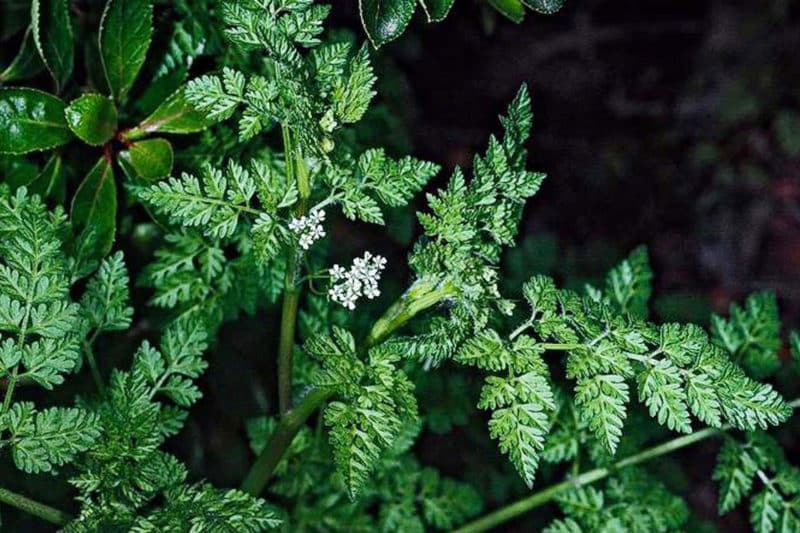
Idenitifcation
Bur chervil (pictured): 1-2 m tall. Clusters of 3-7 small white flowers sit atop 2 cm long stalks. Leaves are fern-like, triangular, and hairy. The seeds are approximately 4mm long with distinctly hooked prickles.
Wild chervil: Similar to Bur Chevil, with a thick taproot that spreads aggressively, as deep as 2 meters into the soil, and is very difficult to remove.
Edible Parts
The entire plant is edible. Leaves taste like mild, licorice-y, parsley. They are very delicate, and lose flavour on cooking; it is best to use them as a garnish. Chervil is in the carrot family, so the root can be cooked with other vegetables.
Cautions
Chervils are closely related to poisonous plants. Take great care with identification, and DO NOT eat a chervil unless you are certain you have IDed it properly.
Look Alikes
Poison Hemlock [!]
Fool's Parsley [!]
Other wild carrots
Cooking
Roots can be used similarly to potato.
Leaves can be used similarly to parsley.
Cirsium Thistles
Canada thistle (Cirsium arvense) and Marsh thistle (Cirsium palustre) are both invasive in BC.
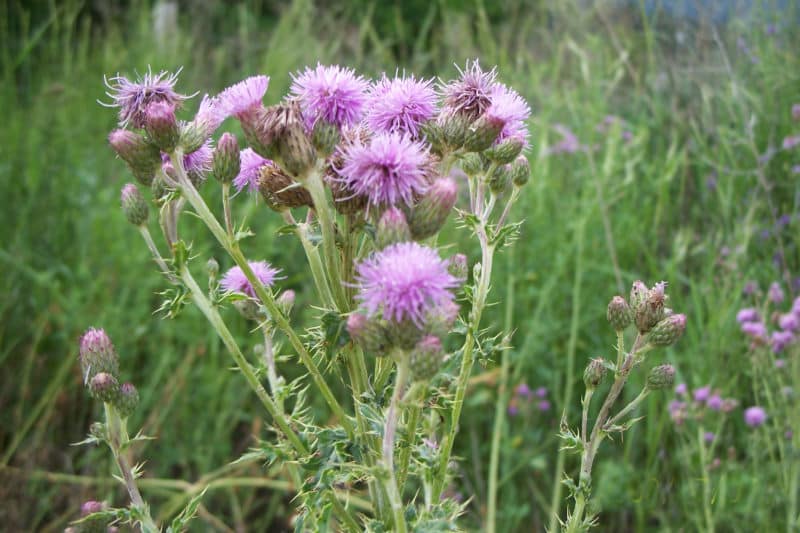
Idenitifcation
Canada thistle: Up to 2m tall. Shiny green leaves with spiny edges. and white hairs on the underside. Clusters of up to five flowers. You can tell Canada thistle from all similar species by its smooth main stem and small flowers.
Marsh Thistle: Up to 3m tall. Stems grow erect, rarely branching and covered in small spines. Spends its first year as a rosette, where leaves are narrow, spiny with dark purple edges.
Edible Parts
Both: Young leaves and shoots can be eaten raw or cooked. Thorns must be removed before eating.
Canada Thistle (pictured): The entire plant is edible. Roots taste of lettuce. Stems are best eaten before flowers appear, otherwise they are stringy and hollow.Peeled flowers are edible and similar to artichokes, but generally considered "not worth the effort."
Cautions
All thistles are edible, but ensure that you do not harvest native thistle species, which look similar.
Look Alikes
Most thistles in the genus Cirsium
Cooking
A green soup base can be made from blanched leaves.
Garlic mustard - Alliaria petiolata

Idenitifcation
In their second year, plants grow from 30–100 cm (rarely to 130 cm) tall. The leaves are stalked, triangular to heart-shaped, 10–15 cm long and 5–9 cm wide, with a coarsely toothed margin (like a saw’s edge). Flowers are small and white with 4 petals arranged in a cross-like shape. The fruit is a pod containing 2 rows of shiny black seeds
Edible Parts
Leaves are best eaten young, as they can get bitter in the summer heat. Roots are spicy, comparable to horseradish. They are best harvested either before or after the plant flowers. Flowers are edible as well, and go nicely in salads.
Cautions
None known (if properly identified).
Look Alikes
Fringecup [!] (shoots only)
Piggy-back Plant (shoots only)
Ground Ivy (shoots only)
Hairy Bittercress
Cooking
Greens can be made into a pesto or a chimichurri.
Shoots can be roasted.
Roots can be used as a horseradish substitute.
Gorse - Ulex europaeus

Idenitifcation
Gorse has a single upright, branching stem. The leaves are green and spine-like with fragrant yellow pea-like flowers. Seedpods are black and hairy. Plants are 1-3 m tall at maturity.
Edible Parts
Flowers and Flower buds are edible, and reported to have a coconuty aroma and an almondy taste.
Cautions
Seeds and seed pods are NOT edible.
Flowers are toxic in large quantites, but fine in small amounts. Best used as a tea, flavouring, or garnish.
Look Alikes
Other species of gorse look similar, but all are similarly edible.
Himalayan blackberry - Rubus armeniacus
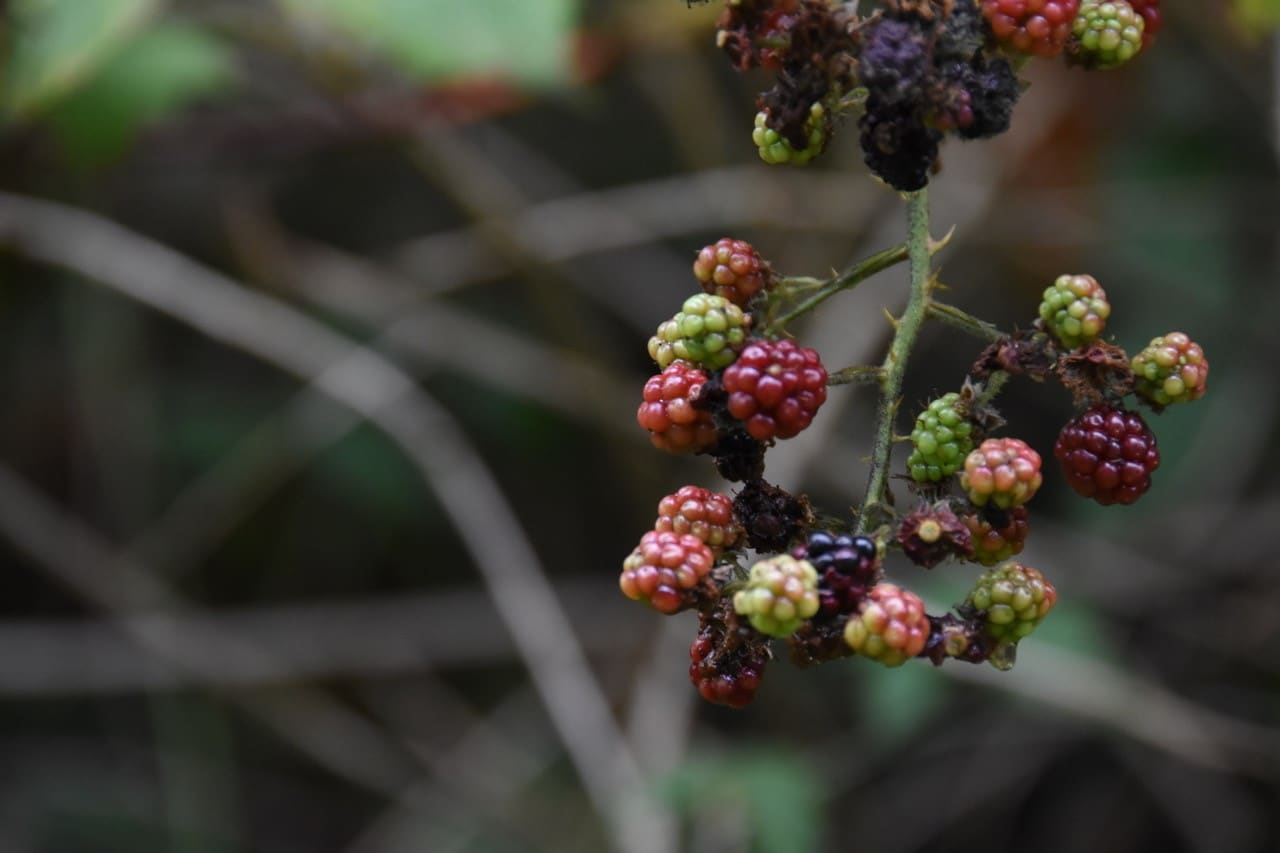
Idenitifcation
Himalayan blackberry can grow up to 5 m tall, with canes up to 12 m long that root wherever they touch the ground. It has small, white to pinkish flowers with 5 petals each. Leaves are large, rounded and generally grouped in fives on first-year canes, and threes on second-year canes. Berries grow to 2 cm long and are round, black, shiny and hairless.
Edible Parts
Berries are large, juicy, and taste like any blackberry from the store. Leaves can be fermented and made into a tea.
Cautions
Himalayan blackberry has long, hard spines that can cause splinters while harvesting.
Leaves may be problematic if consumed in high quantities (including tea).
Look Alikes
Native blackberries can be confused with this invasive. Generally, plants with 3-pronged leaflets are native blackberries while those with 5-pronged leaflets are invasive.
Native salmonberries can look like blackberries. Salmonberries do not have curved thorns.
Cooking
Berries can be used in jams, pies, juices, or any other recipe that calls for supermarket berries.
Young leaves can be fermented, died, and used like tea.
Japanese knotweed - Reynoutria japonica

Idenitifcation
Knotweeds have attractive plumes of small, white to green flowers in the spring. Leaves are heart/triangular-shaped, 8-10cm W x 15cm L, and grow in a zigzag pattern in along the plant’s arching stems. Stems grow tall, straight and densely. They are hollow and green, sometimes with reddish-brown speckles growing 1–5m in height. Stems may persist through the winter as bare, grey- or straw-colored hollow stalks.
Edible Parts
The stem of japanese knotweed is similar to bamboo, juicy, tangy, and tastes like rhubarb. It can be eaten cooked or raw.
Cautions
Japanese knotweed can be confused with many species; ensure your ID is correct before consuming.
Knotweed is especially problematic, and is typically treated with harsh hebicides upon discovery. If you find a knotweed growth, ensure that the area is NOT being treated before consumption.
Look Alikes
Young woody shrubs and trees like dogwood and lilac are often confused with knotweed due to its leaf shape.
Oxeye daisy - Leucanthemum vulgare
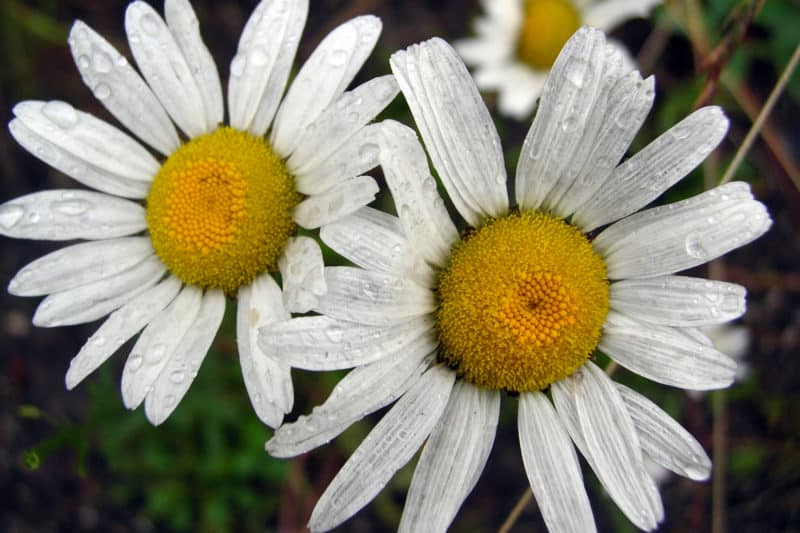
Idenitifcation
Oxeye daisy has single white flowers at the end of stems that contain 20-30 petals and a yellow center. Stems range from 20 to 80cm in height and have wavy leaves that clasp toward the stem.
Edible Parts
Flowers can be dried and used as tea, and flower buds can be eaten raw or pickled. Roots can be eaten raw in the spring. Leaves can be eaten raw or cooked, but their flavour is not well-loved.
Cautions
Oxeye daisy can cause allergic reactions in people with ragweed or pollen allergies.
Look Alikes
Shasta daisy
Other asters
Scentless chamomile (also invasive), not generally considered edible.
Cooking
Leaves and flower buds can be used in salads.
Flower buds can be pickled.
Flowers can be dried and used in tea.
Perennial Sow Thistle - Sonchus arvensis
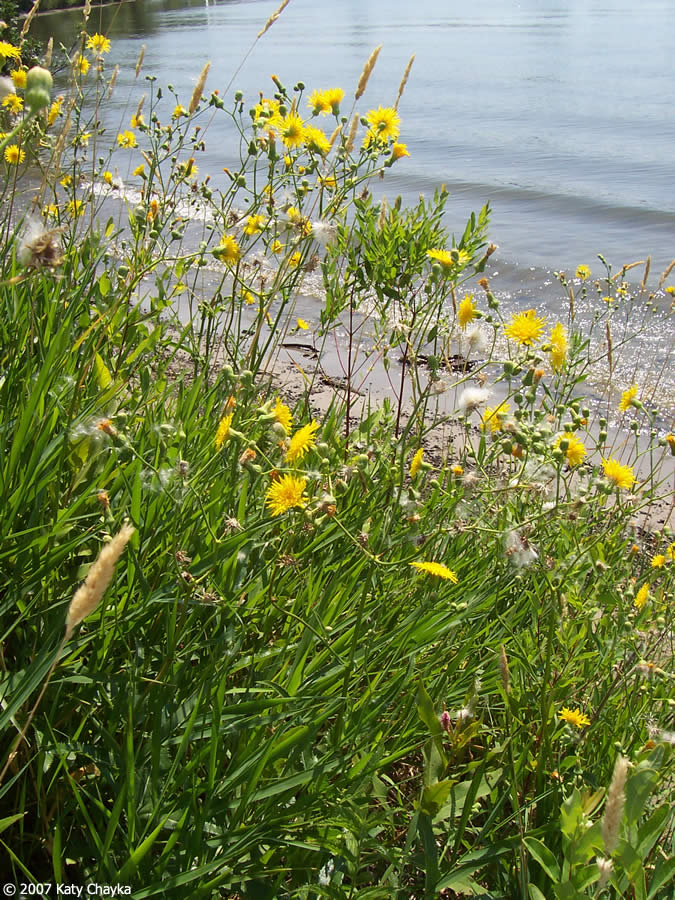
Idenitifcation
Sow thistle looks like a tall dandelion with many flowers sprouting out on each stalk. Its leaves grow from the the base of the plant all the way up the stalk. The stems are unbranched until the top of the plant where the flowers grow.
Edible Parts
Leaves and shoots are edible, but only palatable when young. The young root can be roasted and ground as a coffee substitute.
Cautions
Remove spines before eating!
Look Alikes
dandelion
Prickly sow thistle
Narrow-leaved Hawksbeard
Cooking
Young leaves are generally a substitute for spinach in any recipe.
Queen Anne's Lace - Daucus carota
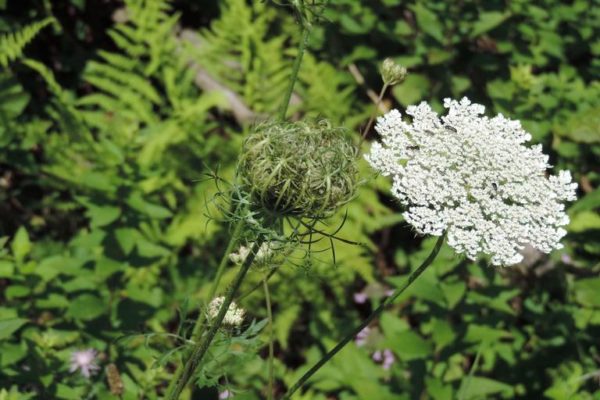
Idenitifcation
Queen Anne’s lace grows up to 1 m in height and has an umbrella-shaped cluster of white flowers at the top of a hairy stem, usually blooming from May to October. Both the plant and its tap root have a carrot like smell.
Edible Parts
Roots can be used in soups and stews. Leaves can be used in salads, and flower clusters can be batter-fried.
Cautions
Queen Anne's Lace is closely related to poisonous plants. Take great care with identification, and DO NOT eat it unless you are certain you have IDed it properly
Look Alikes
Poison Hemlock [!]
Fool's Parsley [!]
Other wild carrots
Scotch Thistle - Onopordum acanthium
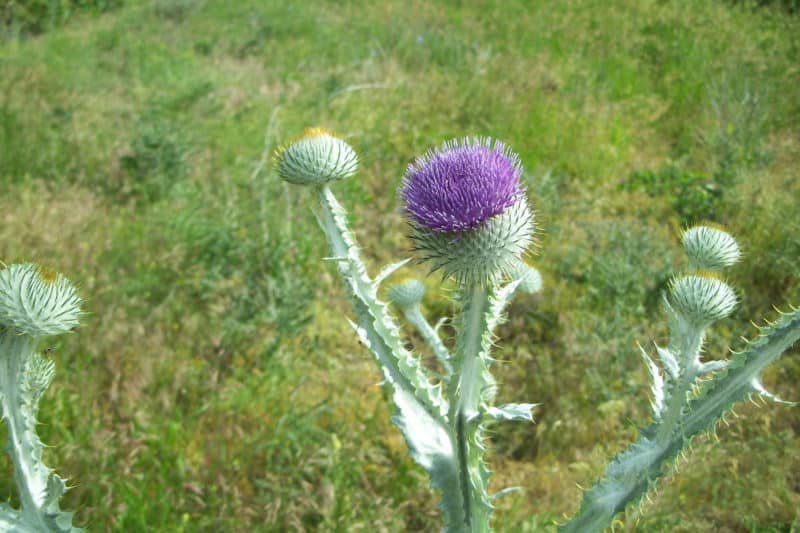
Idenitifcation
Scotch thistle can grow up to 3m tall and has large pink, purple or sometimes reddish flowers. The stems have spine-edged wings that run up the sides. Leaves are irregularly lobed, have sharp yellow spikes, and are covered in woolly hairs that give the foliage a grey-green appearance.
Edible Parts
Flowers can be cooked and used like artichokes. Stems can be cooked in water like asparagus- best if the rind is removed. Leaves and young plants are edible, but prickles must be removed prior to cooking. The plant can be used as an oil seed.
Cautions
There are no real hazards as long as the spines are properly removed.
Look Alikes
Other thistles
Cooking
Apparently the flowers can be dried and used as a vegetarian substitute for rennet in cheesemaking.
St. John’s wort - Hypericum perforatum

Idenitifcation
St. John’s-Wort grows from 0.3–1 m in height and has dark green leaves which show tiny transparent dots when held up to the light. Flowers are bright yellow, with 5 petals each, and grow in clusters at the top of branches. It turns a rusty red colour after finishing flowering late in the summer and autumn.
Edible Parts
Fresh flowers can be made into a tea, or infused into an oil or tincture
Cautions
St. John’s-wort contains a poison that can cause light-coloured farm animals that eat it to have skin burns or blisters when exposed to sunlight. It can also be a skin irritant in some humans.
St. John’s-wort may interact with drugs when consumed, and thus is not recommended for individuals taking medications.
St. John’s-wort may be unsafe to consume in large quantities.
Look Alikes
Tansy ragwort [!]
Other ragworts [!]
Wild Caraway - Carum carvi

Idenitifcation
Wild caraway was introduced to Canada as a spice crop but has escaped cultivation. It is a biennial plant that can quickly outgrow native plants. It can grow in light shade, survive light frost and extra moisture in the soil.
Edible Parts
Whole plant is edible, but the mature seeds at the end of the growing season can be collected and used just like carraway from the store.
Cautions
Be careful not to let seeds fall to the ground while harvesting as it will assist in the spread of the plant.
Look Alikes
Poison Hemlock [!]
Fool's Parsley [!]
Cooking
Seeds can be used just like cultivated caraway.
Is something missing? Let us know.
Images and identification information courtesy of the Invasive Species Council of British Columbia and Minnesota Wildflowers.